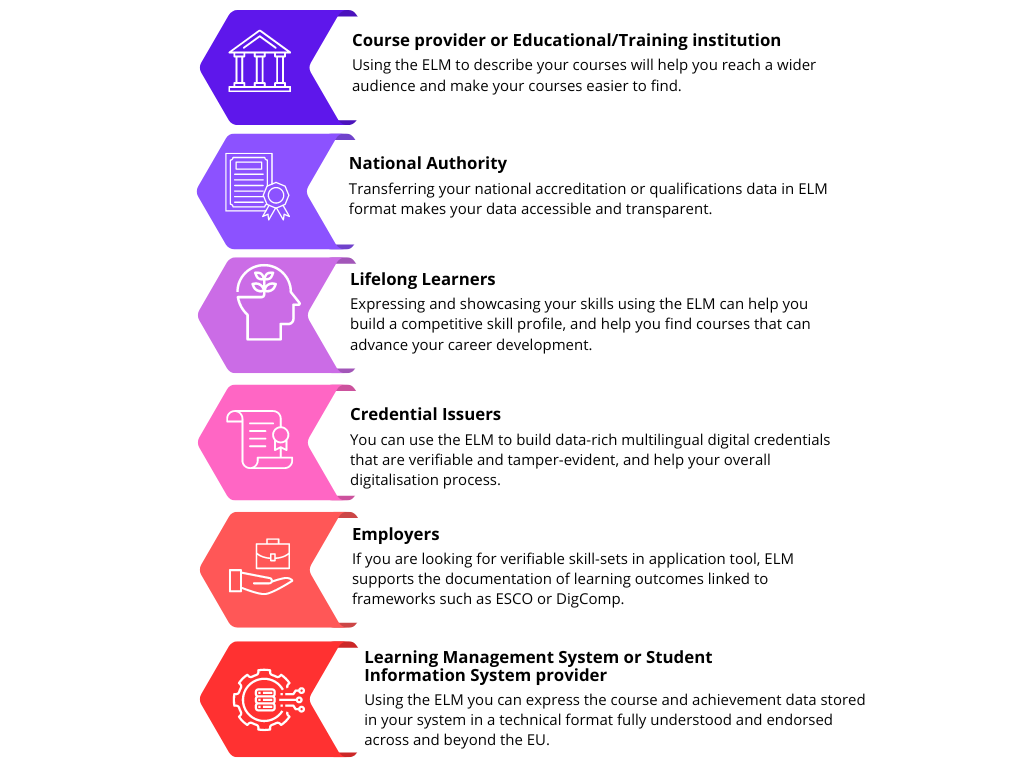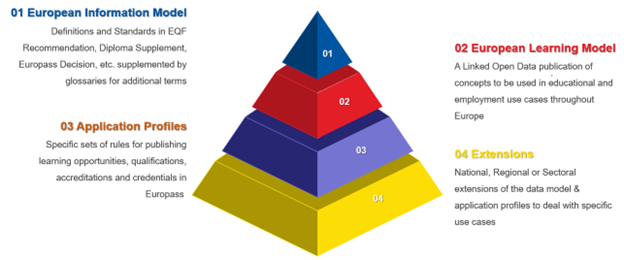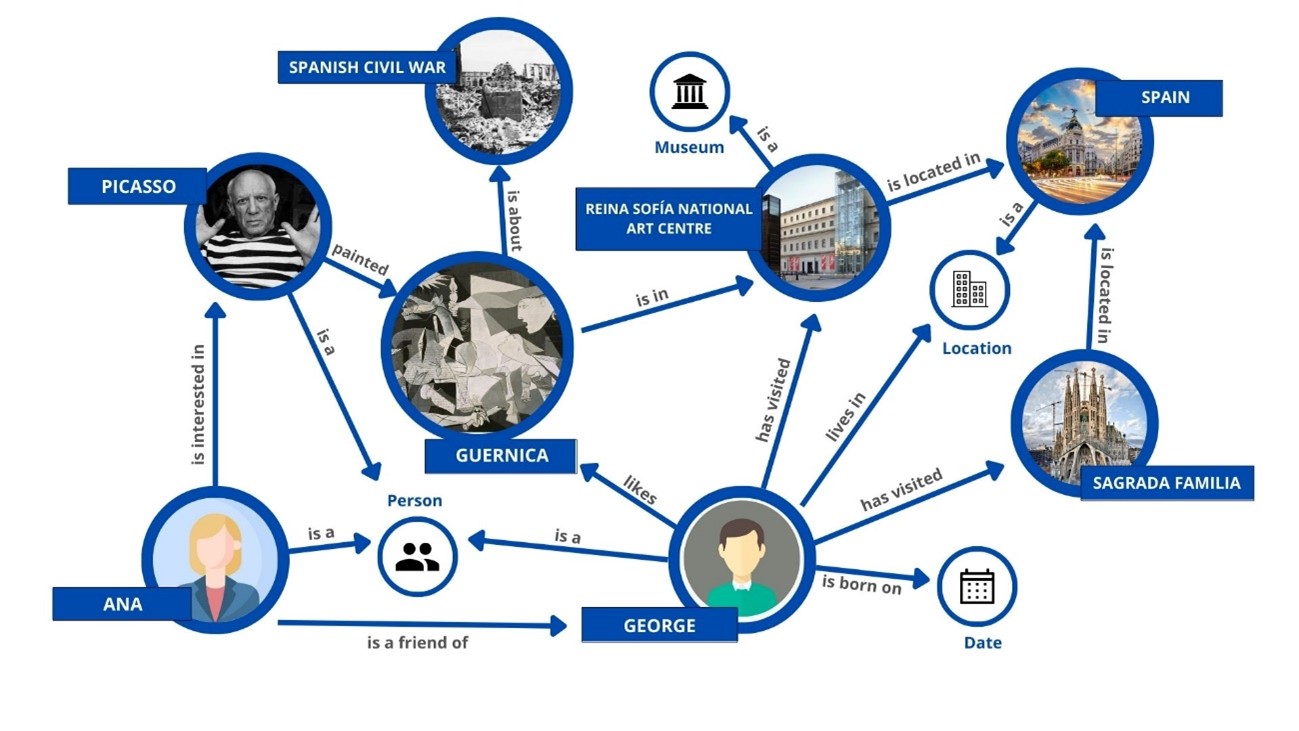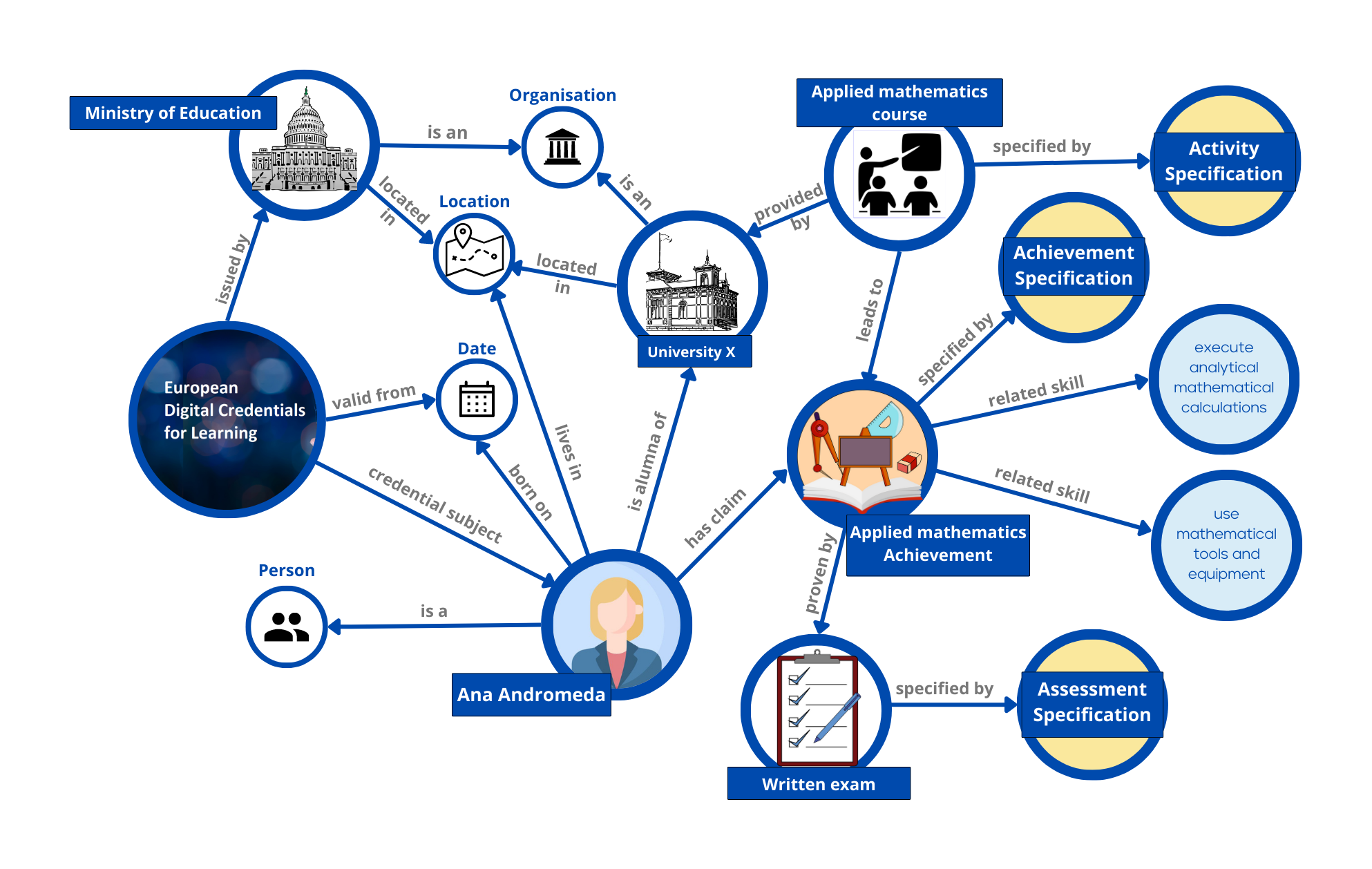Introduction to the European Learning Model
The European Learning Model (ELM) is a multilingual data model providing a single vocabulary for the description of learning in Europe. Having a single model at European level promotes the free movement of workers and learners through comparability, portability and transparency of data.
The uses of the ELM
By providing a unified way to refer to, and to describe all things related to learning, the ELM allows for the understanding of concepts in the same way across countries and organisations. This, in turn, eases the data exchange process across Europe as any organisation or entity working with learning can make use of the same concepts, making the data understandable even across languages. For instance, when providing information about a learning opportunity (such as a university degree programme or a short online course), this information can be presented in a way that is understood across all EU Member States. This way, a potential employer in another country can also discern exactly what a person has learned and achieved through a particular opportunity. The ELM has a multitude of uses, below is a list of the most common ones:

- Providing information about Learning Opportunities and Qualifications. The ELM allows for the record of information in a unified way. Information about learning opportunities and qualifications, including the description of qualification standards, can be used for course catalogues, training announcements and learning opportunity databases, allowing universally comprehensible data to be easily exported and described in the same way across borders.
- Creating and issuing credentials (e.g. diplomas, certificates, examination results, professional certifications, etc.) A digital credential is a documented statement about a person’s learning, e.g. details of event participation, or a set of learning outcomes that describe the knowledge and skills acquired through a particular learning opportunity. The ELM provides the vocabulary to recreate a traditional paper-based certificates and enhance their data content and quality by allowing to provide rich information within the credential itself.
- Taking employer recommendations to the next level. As the ELM captures all aspects of learning, it can be used for the detailed description of non-formal and in-service learning as well, in a standardised, data-rich format that will be understood by other employers or learning providers.
- Issuing student cards, evidence of membership of e.g. professional associations, teacher cards and other identity documents linked to learning. By using the ELM, these documents can be standardised to help their recognition outside of their issuing organisation, sector or country.
- Easing the recognition process. By providing a single multilingual standard to describe learning, the ELM can support and accelerate the recognition processes of diplomas, study-periods abroad and other documents which may be presented to competent authorities across the EU.
- Publishing information on licensing and accreditation of educational institutions and/or their programmes, as well as issuing accreditation credentials to licenced or accredited organisations.
What is a data model and how is it useful?
A data model is an abstract model that organises elements of data and standardises how they relate to one another and to the properties of the real world. It creates a uniform structure for understanding how each concept should be used. In the case of the ELM, this could be how a course is related to an assessment, and how these are part of a degree or qualification. A knowledge graph can help us visualise a data model and understand the connections between different properties.

How does this translate to the ELM?
The ELM consists of four different levels. Overarching, there is the European Information Model which is composed of definitions and standards found in a variety of policy documents and recommendations linked to standards for learning and qualifications in Europe (such as the EQF Recommendation, the Europass Decision, the Diploma Supplement, the Micro-credentials Recommendation etc). This is complemented by glossaries for additional terms from other sources. The second level, the European Learning Model is a general ontology of all concepts that can be used in relation to learning and employment in Europe.
An ontology is a way to organise and represent information, not only providing fixed terminology (by providing a single definition for concepts) as in for instance a taxonomy but also showing the relations between different concepts (for instance, a ‘start date’ will be related to a ‘learning opportunity’) that are being represented and described in the ontology. Within the context of this page, we will generally refer to this level of the model when we mention ELM.

Application Profiles: The concrete use cases of the ELM
The so-called Application Profiles apply specific sets of rules and restrictions on top of the general ontology to ensure that vital data on learning opportunities (e.g. their provider), qualifications (e.g. linked learning outcomes, thematic area and qualifications framework level), accreditations (e.g. accrediting agent) and credentials (e.g. the designation of their issuers and owners) are always supplied (Read more here). These rules set for instance the minimum amount of data to be provided to describe a learning opportunity (for instance, it always needs to have a title), and the format in which it should be provided to ensure cohesion and interoperability.
Finally, it should be highlighted that the ELM also allows for national, regional or sectoral extensions of the data model and the creation of specific additional application profiles to support specific use cases and to adapt the ELM to specific needs.
It is essential to understand how certain concepts (e.g. an Awarding Body, a Learning Achievement or even something as simple as a Location) can be described by standard so-called properties. These properties may include attributes (that can be understood as characteristics providing additional information about properties) such as titles, dates and numbers to denote activity completion or volumes of learning, but also associations between concepts, like Learning Activity − directed by an Organisation.
While the interconnections between all properties are important, to fully understand how some of these associations work, it is important to understand how the concepts relate to one another before getting to their real-life application. It is useful to take a closer look at how the ELM can be understood to be made out of three different layers of concepts. They interact not only to provide general information, but also to apply it in practice to a concrete example or instance (such as a course or a training that has a distinct provider and a start and end date) and ultimately to an individual credential that is specific to its owner:
- Specifications: This is the most foundational concept that can be thought of as the theoretical framework. It specifies what can be learnt, what can be done and how the acquisition and retention of learning outcomes can be assessed. It acts as a ‘recipe’ or ‘set of instructions’ for each of its iterations. For instance, one concept may be a Learning Achievement Specification, which describes what could be learned through an opportunity, providing the abstract description of everything that can be learned in any of the different uses of the specification. This could, for example, be a specific university course’s syllabus, let’s say ‘Applied Mathematics’. Now, ‘Applied Mathematics’ is not necessarily linked to a single opportunity (for instance to a Bachelor’s degree programme in Civil Engineering), it could also be a standalone course that will be proposed to Master students in communications as well, and a compulsory course of all Bachelor degrees proposed by the university. ‘Applied Mathematics’ may (or may not) be proposed to students to new students each year, so there needs to be a more abstract baseline of the course that can be referred to. The Learning Achievement Specification will therefore allow us to describe what could be learnt in this course in relation to all of these different opportunities.
- Opportunities: This is the second level, which describes a particular offer provided by an organisation. The learning opportunity can then include learning activities directed by an organisation or a specific professor, which can lead to learning achievements (that are proven by assessments). Going back to the ‘Applied Mathematics’ course, the opportunity level will allow us to describe this course within the context of a particular opportunity, with a specific start and end date and the designation of the opportunity provider. This concept would then describe the Applied Mathematics course within the Bachelor’s degree in Civil Engineering specifically, provided by the University of Y of Country X, in the first semester running from the 1st of September to November 30th 2023, complete with a concrete assessment (for instance a graded research paper) linked to that course.
- Credentials: This top level allows the concepts to be applied at the level of the individual. Digital Credentials contain distinct claims about a learner/individual, describing elements such as the actual activities they have completed, their specific achievements and, if and where applicable, their specific grades. A credential could be an attendance certificate, a qualification (eg degree), diploma supplement, transcript of records, etc. Using our ‘Applied Mathematics’ course example, in the context of a credential it could describe that Ana Andromeda has participated in the classes necessary to complete the ‘Applied Mathematics’ course, got a 5 - Excellent as a grade, and it is part of her particular degree in Civil Engineering.
The table below may help you further understand the differences between specifications, opportunities and credentials as the different levels of the data model by providing examples on their potential uses with the different types of specifications. Note however that these are fictitious examples, and do not provide an all-encompassing overview of the uses of the different concepts.
| Type | Specification | Opportunities | Credentials |
|---|---|---|---|
| Learning Achievement | The Syllabus of Applied Mathematics, describing the basic components and learning outcomes that could be included, such as learning to use mathematical models in engineering, algorithms in practice etc. | The completed course ‘Applied Mathematics’ starts on the 1st of September 2023 as part of the Bachelor’s Degree in Civil Engineering provided by the University of Brussels. | Ana Andromeda completed the course ‘Applied Mathematics’ with a grade ‘5 – excellent’, proven by a written test, as part of her degree in Civil Engineering awarded in 2025. |
| Learning Activity | The Description of a “Workshop on Sustainability in Digital transitions”: a ‘structure’ and information on a workshop that can be used as a basis for the delivery of multiple workshops through time. | The “Workshop on Sustainability in Digital Transitions” starting on the 30th of May 2023 ending on the 3rd of June 2023, delivered by the Institution of Sustainability in Brussels. | Ana Andromeda received the Micro-credential on participation in the “Workshop Sustainability in Digital Transitions” 30/05-03/06 2023 organised and awarded by the Institution of Sustainability in Brussels. |
| Learning Assessment | A description of the ways in which the acquisition of specific learning outcomes/ skills competences is measured (leading to a learning achievement). For instance, a multiple-choice test measuring a learner’s basic digital skills in accordance with the Digital Competence Framework. | The Multiple-Choice test on Digital Skills taking place on the 23rd of May 2023 in a supervised centre carried out by and assessed be the Public Employment Service Centre in Brussels. | Ana Andromeda received the grade 90% - Excellent in the Multiple Choice Test on Digital Skills of the 23rd of May and this is shown in her transcript of records issued as a credential by the Public Employment Service Centre. |
| Learning Entitlement | Description of an entitlement, for instance the right to practice a profession or enrol in a higher learning opportunity. Following the completion of a nursing degree and the completion of a training program, a person can have the right to work as a certified nurse in country X. |
The program ‘Nursing’ at the professional school of Amsterdam, combined with a training program at a partner university leads to the entitlement to work as a nurse in the Netherlands. |
Ana Andromeda completed the Nursing program at the professional school of Amsterdam and a training program at Amsterdam hospital in 2022. She received her degree as a credential allowing her to work as a nurse in the Netherlands. |
The new ELM v3, what has changed?
A new version of ELM has been released in April 2023.
While previous versions of the ELM were mainly aimed for the use of the European Commission and early adopters running pilots on EDC in 18 EU Member States, and Member States providing learning opportunity and qualifications data to Europass through the Qualifications Dataset Register, the new model is applicable to a more extensive set of education and employment scenarios and can benefit a wider range of stakeholders in Europe.
Formerly, in ELM v2, the application profiles were effectively different models. While they were using approximately the same classes and properties, these were not formally related, and changes applied to one model were not always reflected in others, leading to multiple inconsistencies between models. The new ontology provides a stable standardised vocabulary for the whole united model, and all future adjustments will be reflected across all application profiles.
The ontology is made up of relations between concepts. It means that, for instance, a learning outcome linked to a concrete learning opportunity is the same as the learning outcome linked to the learning achievement specification (or qualification, which is a special type of learning achievement specification) that provides the theoretical foundation for the learning opportunity. The ELM ontology allows the creation of knowledge graphs (see example below) to explain relationships between data points (and clusters), which will be extremely useful in enhancing and strengthening AI models and algorithms, that can be used to power skills assessment tools, learning pathway suggestions, job recommendations and other kinds of automated guidance systems for European citizens. It is also an important step towards the construction of the Common European Skills Data Space.
Each concept is defined in the ELM namespace, allowing anyone building any application or data model to reuse them. A namespace in its essence provides an ‘address’ where each of these concepts can be found (for instance a domain name).
Application Profiles
Visualisation and definition of concepts
- Learning Opportunities and Qualifications (LOQ)
- Accreditation (AMS)
- Person Identity (PID)
- European Digital Credentials for Learning (EDC)
The benefits of ELM v.3:
- One stable version of the model, enjoying the European Commission’s long-term support that is addressing all levels and forms of learning.
- The model is mapped to, and interoperable with, other models, including ELMO and the European Blockchain Services Initiative (EBSI) Diploma Use Case. It is also linked to existing frameworks and classifications, e.g. European Qualifications Framework (EQF), European Skills, Competences and Occupations (ESCO), and International Standard Classification of Education of Fields of Education and Training (ISCED-F).
- Built on open standards, in particular the W3C Verifiable Credential data model.
- Available in all 29 languages of Europass.
- Supports data exchange and credential recognition.
- Aligns with policy developments, EU initiatives and services, including with the Council Recommendation on Micro-Credentials.
- Allows learning providers to use the European Commission’s infrastructure to build and issue data-rich, GDPR compliant digital credentials completely free of charge. European Digital Credentials for Learning, which must be signed with eIDAS compliant electronic seals, shall not be denied legal effect and admissibility as evidence in legal proceedings.
- Allows for data on learning opportunities, qualifications, accreditation and credentials to be visualised, and interpreted in 29 languages, on the Europass portal.
How can you use the ELM?
By using the ELM for your use cases in learning or employment, you support the advancement of European standards and promote interoperability.
The European Learning Model is an extension of the W3C Verifiable Credentials data model expressed as JSON-LD (formerly XML/XSD), for the purposes of providing a standardised format to describe learning within the European Union and European Economic Area.
For further technical information, you can visit the European Learning Model Browser , or find the published ELM at the Publication Office.
To learn more about our application profiles, you can refer to our code.europa repository .
For information on how to issue European Digital Credentials for Learning, please refer to our help pages.
For any additional questions, do not hesitate to contact us at EMPL-ELM-SUPPORT@ec.europa.eu![]() .
.




 Facebook
Facebook
 Twitter
Twitter
 Linkedin
Linkedin